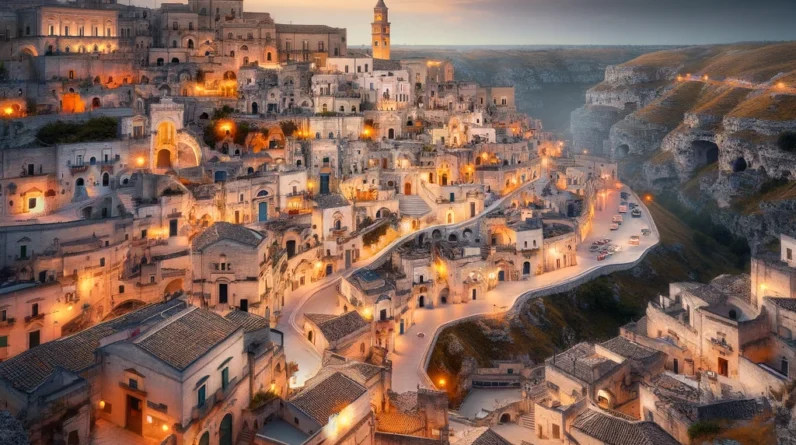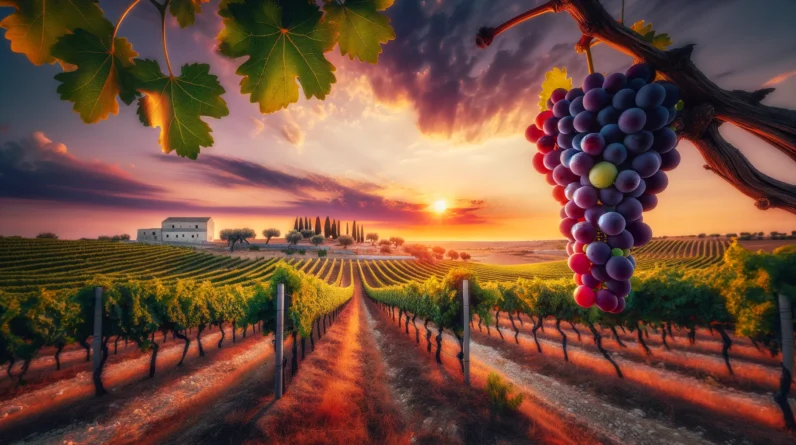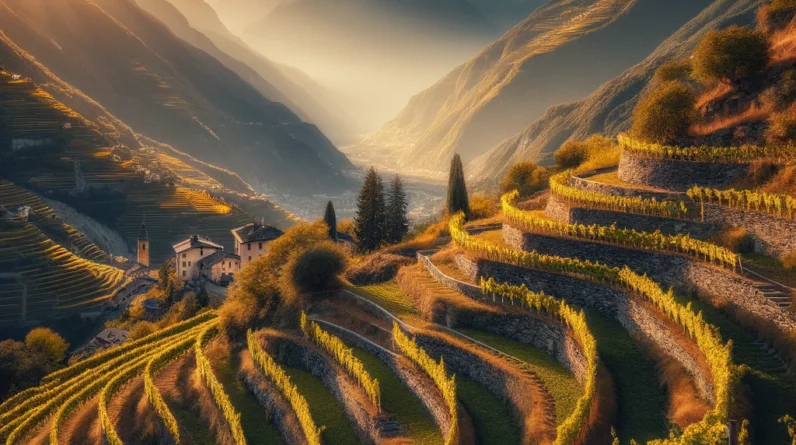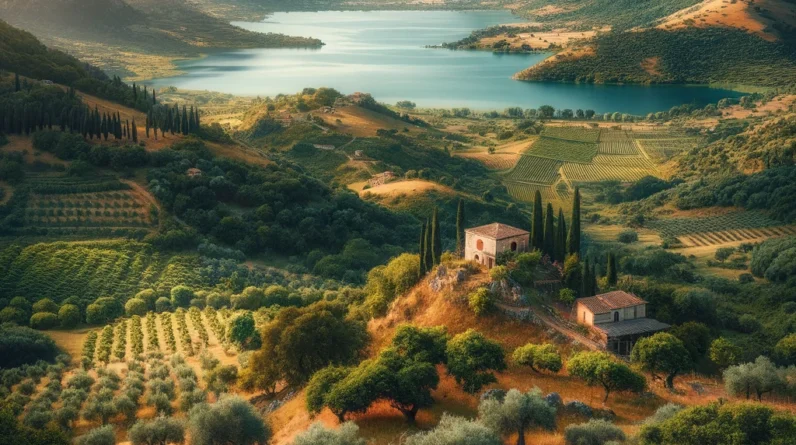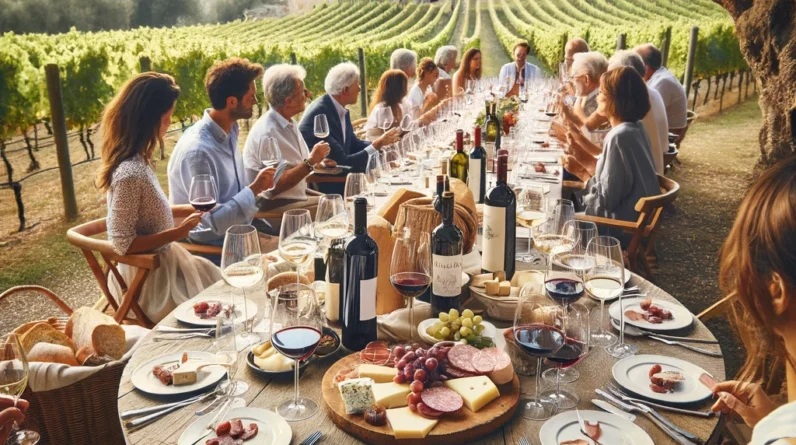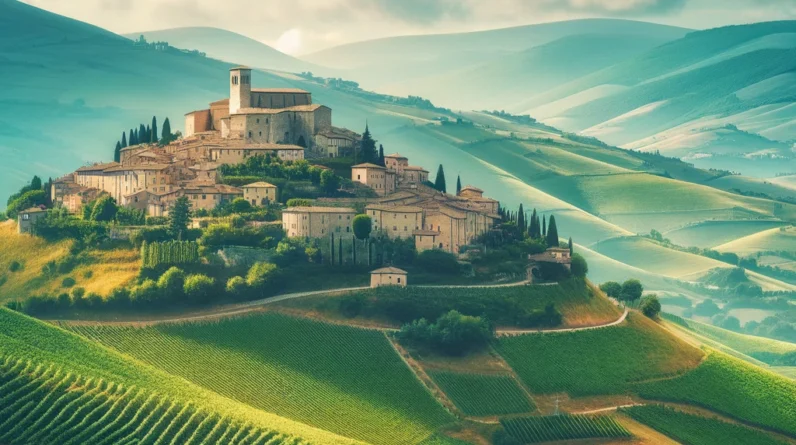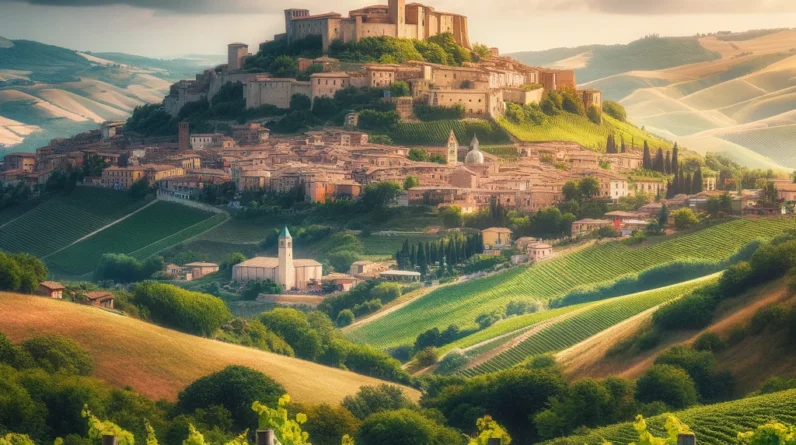
Nestled along Italy’s Adriatic coast lies a region steeped in history, culture, and an enduring passion for winemaking—Marche.
This verdant landscape, characterized by rolling hills, ancient vineyards, and a tapestry of agricultural bounty, is Italy’s hidden treasure, awaiting discovery by those who seek the essence of authentic Italian wine.
The Marche region, with its rich viticultural heritage, offers a unique journey into the world of wine, blending tradition with innovation, and inviting enthusiasts, travelers, and connoisseurs alike to explore its myriad offerings.
From the crisp, aromatic whites to the robust, nuanced reds, Marche’s wines are a testament to the dedication of its winemakers and the richness of its terroir.
This article embarks on an explorative journey through the wines and vineyards of Marche, unraveling the educational nuances of its wine varieties, the enchantment of vineyard tours, the joy of wine discovery, the art of culinary pairings, and the deep-rooted cultural significance of wine in Marche’s daily life.
Join us as we delve into the heart of Marche, where every bottle tells a story of passion, tradition, and the celebration of life’s simple pleasures.
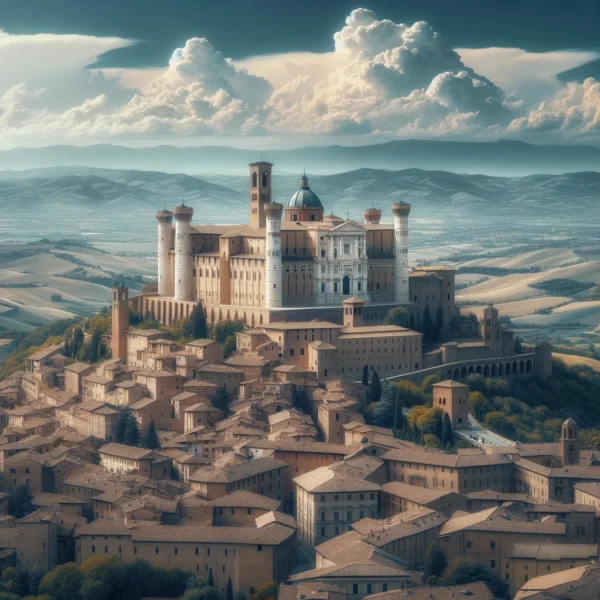
A Journey Through Marche Wines and Vineyards
Marche, a hidden gem in Italy’s wine crown, is celebrated for its distinctive wine varieties.
At the heart lies Verdicchio, a white wine that dances with crisp, mineral flavors, and citrus notes, making it a treasure among wine aficionados.
Not to be overlooked, Rosso Conero and Rosso Piceno offer red wine lovers a taste of Marche’s rich, velvety reds, with a depth that speaks to the region’s unique terroir.
The Marche wine region, nestled along the central eastern coast of Italy, facing the Adriatic Sea, is a picturesque landscape that weaves together a tapestry of rolling hills, ancient vineyards, and medieval towns.
This serene and somewhat underrated region is home to a viticulture as rich and diverse as its history, characterized by a unique terroir that supports the cultivation of a variety of exceptional grapes, leading to the production of some of Italy’s most intriguing wines.
Cultural and Historical Intent: The Soul of Marche in Every Bottle
The history of wine in Marche is a narrative of passion and tradition, where generations of families have nurtured the vines, contributing to the region’s viticultural identity.
This legacy is not just about the wine but the community and culture it fosters.
Terroir
Marche’s terroir is a complex mosaic influenced by its geography, climate, and soil composition, creating a unique environment where vines thrive.
The region benefits from a temperate climate moderated by the Adriatic Sea, which brings cool breezes that temper the summer heat and help maintain the acidity and aromatic qualities of the grapes.
The Apennine Mountains to the west provide protection from cold northern winds, contributing to a relatively stable growing season.
Grapes
Central to Marche’s viticultural success are its grape varieties, with Verdicchio being the star white grape, known for its ability to produce crisp, mineral-driven wines with great aging potential.
Red grapes also play a significant role, with Montepulciano and Sangiovese leading the production of robust, flavorful red wines.
Other notable varieties include Pecorino and Passerina, offering aromatic white wine options, and Lacrima, a red grape that produces distinctively fragrant wines unique to the region.
The Marche region of Italy is renowned for its diverse grape varieties, each contributing unique flavors and characteristics to the region’s celebrated wines.
Below is a table that categorizes the primary grapes found in Marche, detailing their flavor profiles, typical usage in the region’s winemaking, and distinguishing between red and white grape varieties:
| Grape Variety | Flavor Profile | Used in Marche For | Type |
|---|---|---|---|
| Verdicchio
| Citrus, green apple, almond, with a distinct mineral finish | Verdicchio dei Castelli di Jesi, Verdicchio di Matelica | White |
| Montepulciano
| Dark fruits, plum, black cherry, spicy and earthy notes | Rosso Conero, Rosso Piceno | Red |
| Sangiovese
| Red cherry, strawberry, herbal, and earthy tones | Rosso Piceno, some IGT wines | Red |
| Lacrima
| Floral (rose), blackberry, spice, and aromatic herbs | Lacrima di Morro d’Alba | Red |
| Trebbiano
| Lemon, pear, mineral, and sometimes floral notes | Blends and some varietal wines | White |
| Pecorino
| Citrus, floral, peach, with a mineral complexity | Offida Pecorino, other IGT wines | White |
| Passerina
| Tropical fruit, citrus, floral, with crisp acidity | White blends, varietal wines | White |
- Verdicchio is a cornerstone of Marche viticulture, celebrated for its versatility, aging potential, and its ability to reflect the terroir in its flavor profile.
- Montepulciano and Sangiovese are the primary red grapes, producing wines that range from medium to full-bodied, often with the capacity to age and evolve complexity over time.
- Lacrima, a lesser-known red variety, is notable for its distinctive aromatic profile, making wines that are uniquely floral and fruity, with an almost enchanting bouquet.
- Trebbiano, a white grape, is used in various blends across Italy and can produce straightforward, easy-drinking wines with good acidity in Marche.
- Pecorino and Passerina are exciting white grapes gaining popularity for their aromatic profiles and the refreshing, mineral-driven wines they produce, showcasing the diversity and adaptability of Marche’s white wine production.
This table offers a snapshot into the rich tapestry of grape varieties that Marche cultivates, each contributing to the region’s reputation as a producer of both traditional and innovative wines.
The variety of grapes, coupled with Marche’s unique microclimates and soils, allows for a wide range of wine styles that are as inviting as they are diverse.
Soils
The soil composition in Marche varies significantly across the region, contributing to the diversity of wine styles produced.
Coastal areas and rolling hills are often characterized by calcareous clay soils, rich in limestone and minerals, ideal for white grapes like Verdicchio, enhancing their mineral complexity and depth.
Inland areas, particularly those closer to the Apennines, feature a mix of clay, sand, and loam, providing a good foundation for red varieties, contributing to the structure and fruit concentration in the wines.
Climate
Marche’s climate is predominantly Mediterranean, marked by mild winters and warm, dry summers.
The proximity to the sea ensures a balancing act between daytime heat and nighttime cooling, which is crucial for developing a balance of sugar, acidity, and aromatic compounds in the grapes.
The varied topography leads to microclimates that allow winemakers to experiment with different grape varieties and winemaking techniques, further enriching the region’s wine portfolio.
The combination of Marche’s diverse terroir, an array of indigenous and adaptable grape varieties, varied soils, and a favorable climate creates a viticultural paradise.
This region’s wines reflect the essence of its landscape, offering a spectrum of flavors from the crisp, aromatic whites to the rich, nuanced reds.
Marche remains a testament to Italy’s rich winemaking heritage, inviting wine lovers to explore its unique contributions to the world of wine.

The Vineyards of Marche
The vineyards of Marche are a testament to a marriage between traditional and innovative winemaking techniques.
Here, winemakers honor the land, employing sustainable practices to ensure that each bottle captures the essence of its origin.
| Vineyard Name | Designation(s) | Primary Grapes |
|---|---|---|
| Fazi Battaglia
| Verdicchio dei Castelli di Jesi | Verdicchio |
| Garofoli
| Verdicchio dei Castelli di Jesi, Rosso Conero | Verdicchio, Montepulciano |
| Umani Ronchi
| Verdicchio dei Castelli di Jesi, Rosso Conero, Verdicchio di Matelica | Verdicchio, Montepulciano |
| Bucci
| Verdicchio dei Castelli di Jesi | Verdicchio |
| Sartarelli
| Verdicchio dei Castelli di Jesi | Verdicchio |
| Pievalta
| Verdicchio dei Castelli di Jesi | Verdicchio |
| La Monacesca
| Verdicchio di Matelica | Verdicchio |
| Collestefano
| Verdicchio di Matelica | Verdicchio |
| Velenosi
| Rosso Piceno, Lacrima di Morro d’Alba | Montepulciano, Sangiovese, Lacrima |
| Fontezoppa
| Verdicchio di Matelica, Rosso Piceno | Verdicchio, Sangiovese, Montepulciano |
This table showcases a selection of Marche’s vineyards that have made significant contributions to the region’s winemaking reputation.
Each vineyard has its own unique approach to viticulture and winemaking, often combining traditional methods with modern techniques to create wines that are expressive of Marche’s rich terroir.
- Verdicchio dei Castelli di Jesi and Verdicchio di Matelica are two appellations famous for producing high-quality Verdicchio wines, known for their crisp acidity, citrus flavors, and mineral undertones.
- Rosso Conero and Rosso Piceno are notable for red wines made primarily from Montepulciano (and sometimes Sangiovese for Rosso Piceno), offering rich, full-bodied, and sometimes spicy wines.
- Lacrima di Morro d’Alba is a unique, aromatic red wine made from the Lacrima grape, offering distinctive floral and fruity notes.
These vineyards are just a glimpse into the diverse and dynamic wine landscape of Marche, where ancient traditions and modern innovation come together to create some of Italy’s most compelling wines.

The Winemaking Techniques in Marche
Winemaking in Marche is characterized by a blend of traditional techniques that have been passed down through generations, alongside modern innovations that enhance the quality and distinctiveness of its wines.
This combination ensures that Marche wines maintain their deep-rooted connection to the region’s history and terroir while meeting contemporary standards of quality and sustainability.
Here are some key winemaking techniques used in Marche.
Traditional Techniques
Selective Hand Harvesting
Many vineyards in Marche still practice hand harvesting, selecting only the best grapes for wine production.
This method ensures that each grape cluster is carefully inspected, allowing winemakers to maintain high-quality standards and minimize damage to the grapes.
Use of Indigenous Yeasts
To preserve the unique characteristics of their wines, some producers in Marche prefer fermentation with indigenous yeasts—those naturally present on the grapes and in the winery environment.
This approach can add complexity and a sense of place to the wines.
Aging in Traditional Vessels
Aging is a crucial phase in winemaking, and in Marche, traditional vessels such as large oak casks or concrete tanks are often used.
These methods allow the wines to mature slowly, integrating flavors without overpowering the wine with oak, thus maintaining the grape’s natural character.
Modern Innovations
Controlled Fermentation Temperatures
Modern wineries in Marche employ temperature-controlled fermentation tanks to ensure that the wines are fermented at optimal temperatures.
This technology allows for the preservation of the grapes’ delicate aromas and flavors, producing fresher and more fruit-forward wines.
Micro-Oxygenation
Some red wines from Marche benefit from micro-oxygenation, a technique that introduces small amounts of oxygen into the wine during fermentation or aging.
This process can soften tannins and improve the wine’s structure and mouthfeel, making it more approachable at a younger age.
Saturation with Inert Gases
To prevent oxidation and preserve the freshness of the wine, winemakers in Marche may use inert gases such as nitrogen or carbon dioxide during bottling.
This technique is particularly beneficial for preserving the vibrant character of white and rosé wines.
Sustainable and Organic Practices
Organic Viticulture
An increasing number of wineries in Marche are adopting organic farming practices, avoiding synthetic pesticides and fertilizers.
This approach emphasizes the health of the vineyard ecosystem and produces grapes that more accurately reflect the terroir.
Biodynamic Principles
Some producers in Marche follow biodynamic principles, a holistic approach to viticulture that considers the vineyard as an interconnected ecosystem and aligns farming activities with lunar cycles.
Biodynamic practices aim to enhance the vineyard’s biodiversity and vitality, influencing the wine’s quality and expression of place.
Minimal Intervention
In the cellar, a philosophy of minimal intervention is often pursued, with winemakers aiming to let the grapes express their inherent qualities without excessive manipulation.
This can include limited use of additives and a gentle approach to winemaking processes, allowing the unique characteristics of Marche’s grapes and terroir to shine through.
The winemaking techniques in Marche reflect a deep respect for tradition coupled with a willingness to embrace innovation, ensuring that the wines produced are not only of high quality but also true expressions of their origins.

The Uniqueness of Marche
Marche wines hold a special place in the Italian viticulture mosaic for several compelling reasons, blending tradition, diversity, and a unique terroir that collectively define the region’s winemaking prowess.
Here’s what makes Marche wines so special.
Diverse and Unique Grape Varieties
Marche is home to a variety of grape types, both red and white, that are not as commonly found in other regions.
The star among them is Verdicchio, a white grape variety that produces wines with a distinctive crispness, mineral complexity, and aging potential.
The region also celebrates Lacrima for its highly aromatic red wines, Pecorino and Passerina for their fragrant and fresh white wines, and Montepulciano and Sangiovese for robust and structured reds.
This diversity allows for a wide range of wine styles, from delicate and aromatic to full-bodied and complex.
Exceptional Terroir
Marche’s terroir is remarkably varied, thanks to its geographical positioning between the Adriatic Sea and the Apennine Mountains.
This creates a range of microclimates and soil types, from calcareous clay to sandy loam, which are ideal for viticulture.
The climate is typically Mediterranean, with warm summers and mild winters, moderated by sea breezes that help maintain the balance of sugar, acidity, and aromatic compounds in the grapes.
This diverse terroir is reflected in the depth and complexity of Marche wines, which express a strong sense of place.
Balance of Tradition and Innovation
Winemakers in Marche respect their historical roots while embracing modern techniques.
This balance ensures the production of wines that honor the region’s heritage and showcase the potential of its grapes.
Traditional methods, like aging Verdicchio in concrete tanks or large oak barrels to enhance its texture and complexity, coexist with innovative practices, such as using state-of-the-art fermentation techniques to preserve the freshness and purity of fruit in younger wines.
Quality Across Price Points
Marche offers exceptional wines that span a wide range of price points, making it accessible for all levels of wine enthusiasts.
From everyday drinking wines to prestigious bottles destined for aging, the quality-to-price ratio in Marche is highly favorable.
This accessibility encourages wine lovers to explore the region’s offerings, discovering hidden gems that deliver exceptional value.
Culinary Affinity
The wines of Marche are crafted with food pairing in mind, reflecting the Italian tradition of wine as a companion to meals.
Verdicchio, for example, pairs excellently with seafood, a staple of the Marche coastal cuisine, while the region’s reds complement the hearty, rustic dishes typical of its inland areas.
This culinary affinity enhances the dining experience, making Marche wines not just beverages but integral components of Italian gastronomy.
Sustainability and Organic Practices
Many vineyards in Marche are adopting sustainable and organic farming practices, recognizing the importance of biodiversity and environmental stewardship in winemaking.
This commitment to sustainability not only ensures the health of the vineyards and surrounding ecosystems but also contributes to the high quality and distinctiveness of Marche wines.
Marche wines encapsulate the essence of their landscape, embodying a perfect blend of natural beauty, viticultural heritage, and winemaking excellence.
Their special qualities make them a fascinating subject for wine lovers worldwide, inviting exploration and appreciation of this lesser-known yet invaluable piece of Italy’s wine culture.
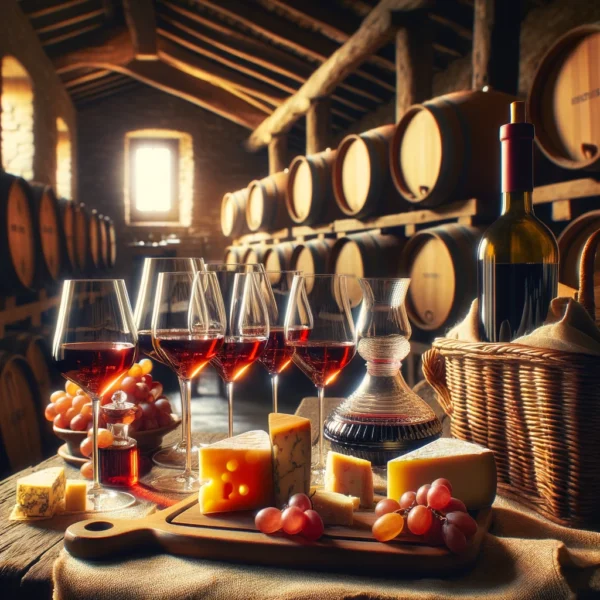
Travel and Tourism
Embarking on a vineyard tour in Marche transports you to landscapes where the beauty of nature meets the artistry of winemaking.
Wineries open their doors to visitors, offering tours that reveal the journey from grape to glass.
Experiences like tasting sessions allow you to savor Marche’s wines, understanding the subtle nuances that each variety presents.
Wine tourism in Marche isn’t just about the wines; it’s about immersing yourself in the culture.
Participate in harvest festivals or sign up for a wine tasting tour that guides you through historic vineyards, offering a glimpse into the soul of Marche.
The Marche region, with its picturesque landscapes, historical sites, and rich cultural heritage, offers a plethora of experiences for travelers seeking beauty, history, and authenticity.
Here are some special places to visit while in Marche.
Urbino
A UNESCO World Heritage site, Urbino is a Renaissance jewel, once home to the great painter Raphael.
The city’s historic center boasts architectural marvels, such as the Palazzo Ducale, which now houses the National Gallery of Marche with an impressive collection of Renaissance paintings.
Conero Riviera
The Conero Riviera offers stunning Adriatic beaches set against the backdrop of the Monte Conero.
Picturesque towns like Sirolo and Numana provide beautiful beaches, crystal-clear waters, and scenic hiking trails through the Conero Park.
Frasassi Caves
One of Europe’s largest and most complex cave systems, the Grotte di Frasassi, are a must-visit for nature enthusiasts.
The caves feature an array of stalactites and stalagmites, with guided tours that reveal the magnificent underground landscapes.
Ascoli Piceno
Known for its medieval architecture and charming piazzas, Ascoli Piceno is a hidden gem.
The Piazza del Popolo, lined with Renaissance buildings and the historic Caffè Meletti, is the heart of the city. Don’t miss the Romanesque church of San Francesco and the Baptistery of San Giovanni.
Loreto
A major pilgrimage site, Loreto is home to the Basilica della Santa Casa, which enshrines the house believed to be the Virgin Mary’s home, miraculously transported by angels from Nazareth.
The basilica’s stunning art and architecture draw visitors and faithful from around the world.
Gradara
Gradara’s fortress and medieval village are famous for their well-preserved walls and the legend of Paolo and Francesca, immortalized by Dante in his Divine Comedy.
The castle offers guided tours and panoramic views of the surrounding countryside.
Monti Sibillini National Park
For outdoor lovers, the Monti Sibillini National Park offers breathtaking landscapes, hiking trails, and the opportunity to explore the rich flora and fauna of the Apennine mountains.
The park is also steeped in legends and offers serene spots like the Lake of Pilato.
Recanati
Birthplace of the poet Giacomo Leopardi, Recanati is a quaint hilltop town offering cultural insights into one of Italy’s literary giants.
Visit Leopardi’s house, now a museum, and the hill of Infinity (Colle dell’Infinito), which inspired one of his most famous poems.
Ancona
The regional capital, Ancona, is a bustling port city with a rich history.
Highlights include the Cathedral of San Ciriaco, perched on a hilltop with views over the Adriatic, and the Arch of Trajan, standing as a testament to the city’s Roman past.
Senigallia
Famous for its velvet beaches and the Rotonda a Mare, Senigallia is a vibrant seaside town.
The summer hosts the Summer Jamboree, an international festival celebrating 1940s and 1950s American music and culture, attracting visitors from across the globe.
Marche combines the charm of Italy’s well-trodden paths with the allure of its undiscovered corners, offering a rich tapestry of experiences that cater to history buffs, nature lovers, and everyone in between.

Practical Tips on Visiting Marche
Visiting the Marche region is a wonderful way to experience the beauty and diversity of Italy, away from the more crowded tourist destinations.
Here are some practical tips to help you make the most of your trip to this enchanting part of Italy.
Best Time to Visit
Consider visiting between spring (April to June) and early autumn (September to October).
These months offer pleasant weather, ideal for exploring the countryside, beaches, and historical sites without the high temperatures or crowds of summer.
July and August are perfect for beach lovers but expect more tourists and higher prices.
Getting Around
Renting a car is highly recommended. Marche’s beauty lies in its sprawling countryside, hilltop towns, and secluded beaches, which are best accessed with your own transport.
Public transport exists but can be infrequent, especially to more rural areas or smaller towns.
Accommodation
Explore a range of options from agriturismi (farm stays) and boutique hotels to B&Bs in historic centers.
Staying in agriturismi can offer a more authentic experience of rural Marche and its lifestyle.
Book in advance if you’re visiting during peak seasons or festivals to secure the best places.
Local Cuisine
Don’t miss out on trying local specialties such as Brodetto di Pesce (fish stew), Olive all’Ascolana (stuffed olives), and Vincisgrassi (Marche lasagna).
Marche is known for its wines, so visit vineyards for tastings.
Verdicchio is a must-try white wine, and for reds, look for Rosso Conero and Rosso Piceno.
Language
Learning a few basic Italian phrases can enrich your experience, as English may not be widely spoken in smaller towns and rural areas.
A phrasebook or translation app can be handy for navigating menus, signs, and interacting with locals.
Cultural Etiquette
Respect local customs and traditions, especially in smaller communities.
Greetings with a simple “Buongiorno” (good morning) or “Buonasera” (good evening) can go a long way.
When visiting churches or religious sites, dress modestly out of respect for local culture.
Beach Etiquette
Many beaches in Marche are equipped with facilities (lidos) that rent out umbrellas and sun loungers.
There are also free public beaches (spiaggia libera), so choose according to your preference.
Beaches can get crowded in July and August, so arrive early to find a good spot.
Explore Beyond the Coast
While the Adriatic coast is stunning, Marche’s interior offers breathtaking landscapes, from the Sibillini Mountains to rolling vineyards and medieval towns.
Make time to explore these areas for a complete experience of the region.
Local Markets and Festivals
Visit local markets to sample fresh produce, cheeses, and other local delicacies.
It’s also a great way to support local artisans and farmers.
Check the calendar for local festivals and events, which can offer unique insights into Marche’s culture and traditions.
Travel Insurance
As with any trip, ensure you have comprehensive travel insurance that covers medical expenses, cancellations, and any activities you plan to undertake.
By following these tips, you can look forward to an unforgettable journey through the Marche region, filled with cultural discoveries, culinary delights, and the serene beauty of Italy’s hidden gem.

Acquiring Marche’s Liquid Treasures
For those looking to purchase Marche wines, the region offers numerous avenues.
Directly buying from vineyards not only supports local winemakers but also gives you access to exclusive vintages.
Online retailers and distributors globally also carry Marche wines, making it easier to add these Italian wonders to your collection.
For collectors, identifying top-rated vintages from Marche can be a rewarding pursuit.
Wines from celebrated vineyards or exceptional years often stand out, promising not just a drink, but an investment in the region’s winemaking legacy.
The Best Vintages in Marche
Identifying the best vintages in a wine region like Marche, known for its diverse range of wines, depends on the type of wine you’re interested in.
However, because wine production and quality can vary significantly from year to year based on weather conditions and other factors, certain years stand out for producing exceptional wines.
In Marche, as in much of Italy, the quality of the vintage can influence the flavor, balance, and aging potential of the wines.
For Verdicchio, which is Marche’s flagship white wine, good years tend to offer wines with excellent balance between acidity and fruit, as well as a great potential for aging.
Meanwhile, for red wines, particularly those made from Montepulciano and Sangiovese grapes, the best vintages are those that provide the necessary warmth and sunshine to fully ripen the grapes, combined with enough rainfall to keep the vines hydrated without diluting the grapes’ flavors.
Notable Vintages in Marche
For Verdicchio
2010: A standout year with a good balance of sunny days and cool nights, leading to wines with excellent acidity and flavor complexity.
2015: This year was noted for its consistent quality, producing Verdicchio with great aromatic intensity and aging potential.
2017: A warmer year that yielded Verdicchio with rich fruit flavors and a fuller body, yet maintaining a good acid structure.
For Rosso Conero and Rosso Piceno (Montepulciano and Sangiovese based reds)
2011: A vintage that provided the warmth needed for reds to develop intense flavors and good tannic structure, making them suitable for aging.
2016: Marked by balanced weather conditions, 2016 produced elegant and well-structured reds, with a good potential for aging.
2018: This year is known for producing red wines with excellent balance, aromatic complexity, and the ability to age gracefully.
General Tips for Identifying Good Vintages
Weather Reports: Look for years with a balanced climate—warm, sunny days during the growing season followed by cool evenings are ideal for both white and red grapes.
Wine Reviews and Ratings: Professional wine critics and publications often provide vintage reports and ratings, which can be a useful guide for identifying the best years.
Winemaker Insights: Sometimes, the best information comes directly from the wineries themselves. Many winemakers are happy to share their thoughts on the qualities of different vintages.
It’s important to note that while some vintages are celebrated for their overall excellence, Marche’s diverse terroir means that different areas within the region can experience varying conditions in the same year.
Therefore, exploring wines from different vintages can be a rewarding way to discover the nuances and expressions of Marche’s unique viticultural landscape.

Savoring Marche on Your Plate
Marche wines shine brightest when paired with food.
Verdicchio, with its crisp acidity, complements seafood splendidly, while the robust flavors of Rosso Conero and Rosso Piceno beautifully match with hearty meats and aged cheeses.
Exploring food pairings opens up a world where wine elevates the dining experience, creating harmony on the palate.
Incorporating Marche wines into cooking can also elevate dishes, adding depth and complexity.
Whether it’s a splash of Verdicchio in a creamy risotto or a reduction of Rosso Conero to accompany a steak, wine becomes an integral ingredient that transforms a meal.
The Marche region, with its rich culinary heritage and diverse landscape, offers a variety of traditional dishes that perfectly complement its wide range of wines.
The cuisine here is a testament to the region’s agricultural bounty, featuring fresh seafood from the Adriatic, hearty meats from its inland farms, and an array of vegetables and herbs that thrive in its fertile soil.
Here are some special dishes from Marche and the wines that pair beautifully with them.
Brodetto di Pesce (Marche Fish Stew)
This savory and aromatic fish stew is a coastal specialty, incorporating a variety of seafood like clams, mussels, prawns, and fish, simmered in a tomato and herb broth.
Pairing: Verdicchio dei Castelli di Jesi, with its crisp acidity and mineral notes, complements the seafood flavors beautifully, cutting through the richness of the stew.
Olive all’Ascolana (Stuffed Fried Olives)
A popular antipasto, these large green olives are pitted, stuffed with a mixture of meats (pork, beef, and chicken), coated in breadcrumbs, and deep-fried.
Pairing: A light and fruity Rosato (rosé) from the region, or a younger, vibrant Rosso Piceno with its cherry and herbal notes, balances the dish’s richness.
Vincisgrassi (Marche Lasagna)
This luxurious lasagna variant includes layers of pasta, rich meat sauce, béchamel, and truffles or wild mushrooms, offering a depth of flavor.
Pairing: A more structured Rosso Conero, with its fuller body, dark fruit flavors, and tannins, stands up well to the complexity and richness of Vincisgrassi.
Coniglio in Porchetta (Rabbit Cooked in the Style of Porchetta)
A dish where rabbit is stuffed with wild fennel, garlic, and other herbs, then roasted to perfection.
Pairing: A Verdicchio di Matelica, slightly more full-bodied than its Castelli di Jesi counterpart, with herbal notes that echo the dish’s seasoning, or a mature Rosso Piceno, whose savory depth complements the rabbit beautifully.
Crescia Sfogliata (Marche Flatbread)
A flaky, buttery flatbread, often served with cured meats and cheeses.
Pairing: Both Verdicchio dei Castelli di Jesi and Verdicchio di Matelica work well, their crispness and acidity cutting through the richness of the bread and charcuterie.
For a red alternative, a light, young Lacrima di Morro d’Alba, with its floral and berry aromas, adds a delightful contrast.
Frustingo (Fruit and Nut Cake)
A traditional Christmas cake made with dried fruits, nuts, honey, and citrus zest, offering a sweet and dense treat.
Pairing: A sweet version of Vernaccia di Serrapetrona, a sparkling red wine, with its berry flavors and effervescence, complements the cake’s richness and fruitiness.
These pairings highlight the synergy between Marche’s traditional dishes and its wines, showcasing how the region’s culinary and viticultural practices have evolved together to offer a truly integrated gastronomic experience.
The diversity of Marche’s cuisine, from the coast to the interior, provides endless opportunities to explore the harmonious interactions between food and wine.
Wine in Marche transcends being a mere beverage; it is a celebration of life, integral to local festivities, traditions, and everyday moments. It embodies the spirit of Marche, encapsulating the region’s history, its people’s labor, and the joy that comes with sharing a bottle.
FAQs:
1. What types of wine is Marche known for?
Marche is renowned for its white wines, especially those made from the Verdicchio grape, such as Verdicchio dei Castelli di Jesi and Verdicchio di Matelica, known for their crisp, mineral, and sometimes floral notes.
The region also produces notable red wines, primarily from Montepulciano and Sangiovese grapes, like Rosso Conero and Rosso Piceno, offering rich and robust flavors.
2. Can you visit vineyards in Marche?
Yes, many vineyards in Marche welcome visitors for tours, tastings, and direct purchases.
These experiences can range from casual tastings to in-depth tours of the vineyards and cellars, often requiring prior booking.
3. What makes Marche’s terroir unique?
Marche’s terroir benefits from a Mediterranean climate with sea breezes from the Adriatic, protecting hillsides, and diverse soil types, from calcareous clay to sandy loam.
This combination creates ideal conditions for a variety of grapes to flourish, producing wines with distinct flavors and aromas.
4. Are there any unique grape varieties in Marche?
Beyond the widely celebrated Verdicchio, Marche is home to unique grape varieties such as Lacrima, used in Lacrima di Morro d’Alba for its distinctive floral and fruity aromatics, and Pecorino, known for its high acidity and aromatic complexity.
5. How can I buy wines from Marche?
Wines from Marche can be purchased directly from vineyards, through specialty wine shops, or online retailers.
Many producers also distribute their wines internationally, making them accessible worldwide.
6. What food pairings work well with Marche wines?
Verdicchio pairs wonderfully with seafood, pasta with white sauces, and light meats, enhancing the dishes’ flavors without overpowering them.
Red wines from Marche, like Rosso Conero and Rosso Piceno, are excellent with red meats, game, and aged cheeses, complementing their richer, fuller flavors.
7. What are the best times to visit Marche for wine tourism?
Spring (April to June) and fall (September to October) are ideal for visiting Marche’s vineyards, offering pleasant weather, scenic landscapes, and the opportunity to participate in harvest activities during the autumn months.
8. Are there any wine festivals in Marche?
Yes, Marche hosts several wine festivals and events throughout the year, celebrating its viticulture and offering opportunities to taste and learn about the region’s wines.
Key events include the Verdicchio Festival in summer and various local wine celebrations in the harvest season.
9. How does the climate affect wine production in Marche?
The Mediterranean climate, characterized by mild winters and warm summers, moderated by sea breezes, ensures optimal ripening of grapes.
The diurnal temperature variations contribute to developing the grapes’ aromatic compounds and preserving their acidity, essential for the freshness and complexity of Marche wines.
10. What are some must-visit vineyards in Marche?
While there are many noteworthy vineyards, Fazi Battaglia, Garofoli, Umani Ronchi, and Bucci stand out for their quality and the immersive experiences they offer.
Each vineyard showcases the diversity and excellence of Marche’s wine production.

Experience Wine Like Never Before with Coravin!
🍷 Introducing the Coravin Model Limited Edition Wine Preservation System in Steel Blue 🍷
🌟 Savor Every Drop: Why settle for just one bottle? With Coravin, enjoy any wine, any time, without ever pulling the cork. Your wine collection, unlocked with unparalleled freedom.
💎 Elegant Design, Superior Quality: Crafted in stunning Steel Blue and made with durable stainless steel, this isn’t just a wine tool; it’s a centerpiece that speaks to your sophisticated taste.
🚀 State-of-the-Art Technology: Featuring a Teflon coated wine needle, pour your wine smoothly and effortlessly, preserving every cork and every flavor.
🌬️ Ultimate Preservation: Each Coravin capsule uses ultra-pure argon gas to protect your wine from oxidation. Your last glass will be just as perfect as your first, even years later.
🎉 Perfect for Every Occasion: Whether you’re hosting a party or enjoying a quiet evening, Coravin ensures your favorite wine is always on the menu.
💡 Easy and Convenient: Celebrated for its ease of use and light weight, make every pour a joyous experience.
💸 A Wise Investment: Praised for its value for money, Coravin is not just a luxury; it’s an essential for every wine lover.
🌐 Ready for the World: Designed for US outlets but adaptable globally, your Coravin experience knows no bounds.
👉 Get Yours Today! Elevate your wine experience with Coravin. 🍇✨


